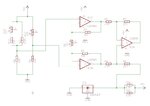igru25
Newbie level 4
Hello!
I am beginner in electronics and i try to make instrumental amplifier for my strain gauge.
I have already made following circuit based on LM358, but i am not sure if it is OK.
I apply multimeter between Vref (LM336) and output and see voltage jumping up and down - from 4mV to 1.2V even if no force to strain gauge applied.
My circuit is a compilation of everything i could find in internet for single supply.
Can someone tell me if it looks ok or not? Or how could i debug circuit having old 20MHz oscilloscope?
Some data:
Strain gauge - 120 Ohm. I want to analyze small finger press force (measured bridge output voltage from 0mV to 1mV).
Rgain = 200Ohm (Gain = 400).
Thanks in advance.

I am beginner in electronics and i try to make instrumental amplifier for my strain gauge.
I have already made following circuit based on LM358, but i am not sure if it is OK.
I apply multimeter between Vref (LM336) and output and see voltage jumping up and down - from 4mV to 1.2V even if no force to strain gauge applied.
My circuit is a compilation of everything i could find in internet for single supply.
Can someone tell me if it looks ok or not? Or how could i debug circuit having old 20MHz oscilloscope?
Some data:
Strain gauge - 120 Ohm. I want to analyze small finger press force (measured bridge output voltage from 0mV to 1mV).
Rgain = 200Ohm (Gain = 400).
Thanks in advance.

Last edited: